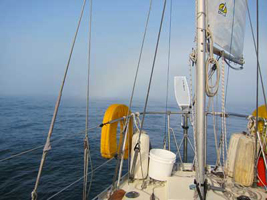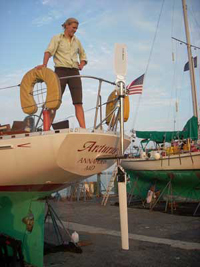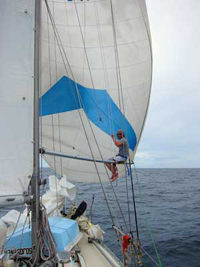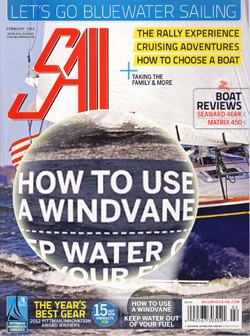|
SAIL Magazine
February 2012 issue
STEERED BY THE WIND
Courtesy SAIL Magazine and Andy Schell (fathersonsailing.com)
It’s not as easy as pressing a button, but once you
learn to use a windvane you’ll never get stuck hand-steering again
by Andy Schell
 There is a definite learning curve to overcome when
using a mechanical self-steering windvane for the first time. Due mainly
to a vane’s inability to follow a compass heading and the fact that a
boat’s sails must be balanced for a vane to work well, many sailors new
to vanes get discouraged and quickly abandon them. This is a shame, as a
windvane is an ingenious bit of engineering. Simple and robust, There is a definite learning curve to overcome when
using a mechanical self-steering windvane for the first time. Due mainly
to a vane’s inability to follow a compass heading and the fact that a
boat’s sails must be balanced for a vane to work well, many sailors new
to vanes get discouraged and quickly abandon them. This is a shame, as a
windvane is an ingenious bit of engineering. Simple and robust,
 they are
often cited by their proponents as the single-best piece of gear on a bluewater boat. It works well on its own and can be an invaluable
back-up to an electronic autopilot. they are
often cited by their proponents as the single-best piece of gear on a bluewater boat. It works well on its own and can be an invaluable
back-up to an electronic autopilot.
Arcturus, our 1966
Allied Seabreeze yawl, has a Cape Horn servo-pendulum windvane, which
operates on the same principle pioneered by Blondie Hasler back in the
1960s. A vertical tube supports the air vane, which pivots on a
horizontal axis at its base. The leading edge of the vane is set facing
into the wind, and when the boat veers off course, the wind catches one
of the vane’s flat sides, causing it to topple over. A linkage inside
the vertical tube transfers that force to the steering oar, rotating it
like a rudder on a vertical axis. The oar, which is also hinged at the
top to pivot on a horizontal axis, is consequently deflected sideways by
the water flowing past it. This force–which is considerable, especially
at speed–is transferred via a steel stock in a horizontal tube mounted
through the boat’s transom to a small steering quadrant mounted inside
the boat. Control lines run from this quadrant to the boat’s main
steering quadrant, or can run directly to a wheel or tiller.
All modern servo-pendulum units work on this
principle, though most have steering control lines running directly from
the steering oar to a boat’s wheel or tiller. The genius of the system
is that it harnesses the power of the wind and sea to do the work. The
harder the wind blows and the faster the boat sails, the more force
there is available to bring the boat back on course when it starts to
wander.
Balancing Act
My wife Mia Karlsson and I (and our good friend Clint
Wells) got our own taste of the windvane learning curve during a
transatlantic passage last
 summer.
We soon learned that maximizing a vane’s efficiency requires a slightly
different understanding of sail trim. On a fully crewed racing boat sail
trim is optimized for very specific wind angles to maximize boatspeed,
requiring constant trim adjustments and precise hand-steering. On a
short-handed cruising boat, maintaining that kind of efficiency is
unsustainable. To get our windvane working well, we sacrificed boatspeed
and sought a “median” sail trim that allowed the vane to more easily
compensate for minor changes in wind speed or direction. summer.
We soon learned that maximizing a vane’s efficiency requires a slightly
different understanding of sail trim. On a fully crewed racing boat sail
trim is optimized for very specific wind angles to maximize boatspeed,
requiring constant trim adjustments and precise hand-steering. On a
short-handed cruising boat, maintaining that kind of efficiency is
unsustainable. To get our windvane working well, we sacrificed boatspeed
and sought a “median” sail trim that allowed the vane to more easily
compensate for minor changes in wind speed or direction.
In practice, this means a boat should often be
slightly undercanvassed. During our passage, I found Arcturus
could maintain reasonable speed off the wind with surprisingly little
sail area. Upwind, the genoa and mizzen was usually enough to make five
knots, and weather helm was nonexistent. Downwind, we experimented with
the large drifter set on the spinnaker pole and the full mainsail
prevented out on the other side, sailing wing-and-wing. The boat was
fast for sure, but to my delight, we found we could sail almost as fast
with only the 100% jib and two reefs in the main. We slept much better
at night knowing Arcturus would remain stable if the wind
increased considerably, and the windvane required far less attention.
When setting the vane, our first check was always
sail trim. “When in doubt, let it out.” It is amazing how far a mainsail
can be eased before it starts to luff, and the influence an over-trimmed
main has on helm balance and vane performance is substantial.
If easing the main right out to the shrouds did not
ease the helm and help the vane settle down, we knew it was time to
reef–our second mental check. No self-steering device can overcome a
poorly balanced boat. Hand-steering while trimming sails quickly reveals
the influence of sail trim on helm balance. Experiment. The goal should
be to steer with your fingertips. The easier it is for you, the easier
it is for your vane to steer. Fundamentally, setting up the boat for
windvane steering is really nothing more than learning the boat. Most
experienced ocean sailors will agree that learning to use a windvane
actually makes you a better sailor.
When a boat is perfectly balanced, a windvane’s
steering control lines should be tensioned equally. We put whippings on
each of our lines to measure this, and control-line tension was the
third point on our mental checklist. It is good practice to initially
set the control lines equally. Adjusting the tension affects weather
helm. Slightly over-tensioning the windward control line relative to the
leeward line, for example, will hold the helm down in order counter a
boat’s natural tendency to round up. In practice, we found this was
often necessary, but you have to be careful. If you have to put too much
“English” on the control lines to maintain course, you’re only masking
an imbalance somewhere else. The control lines should remain within an
inch or two of a neutral setting. Beyond that, it is time to make other
adjustments. Usually you’ll need to reef.
Once a boat is properly balanced, a vane should steer
a straight course, at least as good as most human helmsmen. Arcturus
stayed within ten degrees either side of our intended course when we had
our vane working well. It may sound obvious, but if your boat is
balanced, the sails are reefed down, the control lines are set
correctly, and the vane is still not steering where you want, you need
to check its alignment. The vane steers to the apparent wind, so
slightly adjusting its angle relative to the wind will immediately
affect the course.
Refinements
The action of air vanes on most mechanical
self-steering units is dampened by a counterweight set below the vane’s
pivot point. This helps keep the boat from yawing excessively, as the
air vane is never truly edge-to-the-wind for more than an instant. In
effect, it is the equivalent of the damping control found on most
electronic autopilots.
On the Cape Horn unit, an adjustable bungee cord
supplements the inertial force of the counterweight and allows you to
fine-tune its effect. Experienced users often add such cords to the
counterweights on other types of windvanes. In lighter airs, we
tightened our bungee cord to prevent the vane from over-correcting. The
less sensitive the vane is to the wind, the less force it exerts on the
steering oar–and subsequently the helm–and vice versa. Conversely, when
the wind picked up, we eased the cord to increase the vane’s power. On a
true beam reach, generally the most challenging point of sail for a
windvane, the control lines should be set very close to equal. We often
found that minor adjustments to the bungee damping control were most
effective when dialing in a course on this point of sail.
Another way we could fine-tune the performance of our
Cape Horn unit was to change air vanes. In light air we used a
lightweight vane made of spinnaker sailcloth stretched over a thin steel
frame; in stronger winds we used a heavier, solid aluminum vane.
Generally, we changed vanes after the first reef was taken. Other
manufacturers also offer air vanes of different weights, or users can
fabricate their own.
The biggest drawback to a windvane, once you’ve
mastered it, is that it only steers to the wind. You can, however, fit a
small electronic tiller pilot to “steer” the air vane in place of the
wind. In this way, the vane can steer a compass course and keep you off
the helm when conditions are calm. The tiller pilot, as it controls only
the air vane, uses a tiny fraction of the power consumed by a
conventional electronic autopilot.
Conclusions
 During our 2,000-mile voyage, Mia, Clint and I only
hand-steered for fun. So long as there was wind to keep the sails full,
the vane had no problem maintaining a course upwind or down. It even
steered running under bare poles while we did foredeck work. During the
crossing from Canada to Ireland, about 1,000 miles offshore, we sailed
for a couple days downwind under a symmetric spinnaker with the vane
doing all the work with barely a tickle of apparent wind noticeable at
the stern. During our 2,000-mile voyage, Mia, Clint and I only
hand-steered for fun. So long as there was wind to keep the sails full,
the vane had no problem maintaining a course upwind or down. It even
steered running under bare poles while we did foredeck work. During the
crossing from Canada to Ireland, about 1,000 miles offshore, we sailed
for a couple days downwind under a symmetric spinnaker with the vane
doing all the work with barely a tickle of apparent wind noticeable at
the stern.
Most sailors name their windvanes. On Arcturus,
it took time to get acquainted with ours. Mia and I got married in
Sweden only two weeks before our departure from Canada, and the voyage
was to be our honeymoon, a delivery cruise to Scandinavia. We finally
christened our vane “Sune-the-Driver” (pronounced SOO-neh), after
the white-haired gentlemen who drove us away from the church in his
vintage Volvo. Offshore, it was Sune-the-Driver who steered us home.

|
 There is a definite learning curve to overcome when
using a mechanical self-steering windvane for the first time. Due mainly
to a vane’s inability to follow a compass heading and the fact that a
boat’s sails must be balanced for a vane to work well, many sailors new
to vanes get discouraged and quickly abandon them. This is a shame, as a
windvane is an ingenious bit of engineering. Simple and robust,
There is a definite learning curve to overcome when
using a mechanical self-steering windvane for the first time. Due mainly
to a vane’s inability to follow a compass heading and the fact that a
boat’s sails must be balanced for a vane to work well, many sailors new
to vanes get discouraged and quickly abandon them. This is a shame, as a
windvane is an ingenious bit of engineering. Simple and robust,
 they are
often cited by their proponents as the single-best piece of gear on a bluewater boat. It works well on its own and can be an invaluable
back-up to an electronic autopilot.
they are
often cited by their proponents as the single-best piece of gear on a bluewater boat. It works well on its own and can be an invaluable
back-up to an electronic autopilot. summer.
We soon learned that maximizing a vane’s efficiency requires a slightly
different understanding of sail trim. On a fully crewed racing boat sail
trim is optimized for very specific wind angles to maximize boatspeed,
requiring constant trim adjustments and precise hand-steering. On a
short-handed cruising boat, maintaining that kind of efficiency is
unsustainable. To get our windvane working well, we sacrificed boatspeed
and sought a “median” sail trim that allowed the vane to more easily
compensate for minor changes in wind speed or direction.
summer.
We soon learned that maximizing a vane’s efficiency requires a slightly
different understanding of sail trim. On a fully crewed racing boat sail
trim is optimized for very specific wind angles to maximize boatspeed,
requiring constant trim adjustments and precise hand-steering. On a
short-handed cruising boat, maintaining that kind of efficiency is
unsustainable. To get our windvane working well, we sacrificed boatspeed
and sought a “median” sail trim that allowed the vane to more easily
compensate for minor changes in wind speed or direction. During our 2,000-mile voyage, Mia, Clint and I only
hand-steered for fun. So long as there was wind to keep the sails full,
the vane had no problem maintaining a course upwind or down. It even
steered running under bare poles while we did foredeck work. During the
crossing from Canada to Ireland, about 1,000 miles offshore, we sailed
for a couple days downwind under a symmetric spinnaker with the vane
doing all the work with barely a tickle of apparent wind noticeable at
the stern.
During our 2,000-mile voyage, Mia, Clint and I only
hand-steered for fun. So long as there was wind to keep the sails full,
the vane had no problem maintaining a course upwind or down. It even
steered running under bare poles while we did foredeck work. During the
crossing from Canada to Ireland, about 1,000 miles offshore, we sailed
for a couple days downwind under a symmetric spinnaker with the vane
doing all the work with barely a tickle of apparent wind noticeable at
the stern. 


